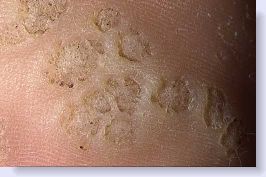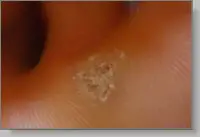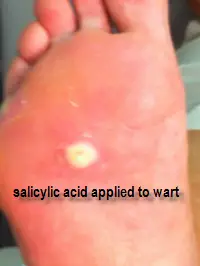plantar warts
AUTHOR: Marc Mitnick DPM home --> wartsWHAT CAUSES PLANTAR WARTS
This is a skin condition very commonly seen on the feet. More commonly known as a plantar wart (plantar, meaning bottom of foot) these growths are viral in nature. They are caused by the human papillomavirus (HPV). The virus is everywhere which may explain why this growth affect about 9 million Americans every year.
The virus thrives in warm moist environments such as public pools and locker rooms and transmit by direct contact. They are considered benign tumors. The lesions generally occur spontaneously, but many times can be seen in areas of trauma such as after stepping on something that penetrates the skin thus creating an opening for the virus to manifest itself. Depending on where they are located on the foot, they can be painful.
More often than not if left untreated they will spread by auto-inoculation particularly in children but also in immuno-compromised adults, but they are also known to spontaneously disappear as well.
A Wart can present as a solitary lesion or they can appear in clusters more commonly known as a mosaic. Many times they are more painful when squeezed compared to direct pressure applied to them. They contain their own blood supply which is represented by the black dots that you may see within them. That is also the reason they bleed so readily when they are scraped.
Over the years I have seen many doctors who do not specialize in foot problems, misdiagnose warts. Many times they are misdiagnosed as calluses (or calluses are mistakenly called warts). Other conditions such as porokeratosis, or plugged sweat glands are erroneously called warts.
images of plantar warts
Below is a picture of mosaic plantar warts.

|

|
The picture above is a solitary wart located on the bottom of the foot just behind the third toe.
HOW DO YOU TREAT PLANTAR WARTS
There are what seem to be a hundred different treatments which tell you that there is no acceptable treatment. There is also an abundance of folk remedies, the reason being that since warts can spontaneously disappear, the remedies end up getting the credit.
There is a very high recurrence rate. The problem with a plantar wart compared to a wart elsewhere on the body, is that the ones located elsewhere are generally outgrowths, meaning that they grow out from the skin so most of the growth is visible making treatment simple. Unfortunately, a wart on the bottom of the foot is pushed inward from walking on them meaning the majority of the growth is beneath the skin. This is complicated by the fact that many parts of the bottom of the foot contain thick skin further protecting the growth from treatment.
Does a wart need to be treated? One or two solitary lesions that do not hurt can be left alone and watched in the hopes that they may spontaneously disappear. However, should one notice that the warts are beginning to spread, treatment is highly recommended; the logic being that if ignored the growths will continue to spread, possibly become painful, and that the more warts one has, the harder it will be to eradicate all of them.

|
Treatment depends on their location and the number of warts present. A Wart over a bony prominence such as the ball of the foot should never be surgically removed because if a scar develops it may be as painful as the original wart.
There are a million wart medications on the market, most of which are not strong enough for plantar warts (because the wart is beneath the skin). However, a foot specialist has available, stronger medications which in conjunction with regular paring of the wart will eradicate most cases of warts. The upside to this treatment is that it is a reasonably painless experience and there should be no limitation on activity. The downside is that it can sometimes take a long time to eventually get rid of the wart. Take a look at the picture of the wart to the left. This wart is being treated with salicylic acid ointment by prescription. I actually placed this picture on the site to show my patients what a wart should look like when the proper amount of acid is being applied. If the immediate surrounding area becomes macerated, such as in this picture, then the proper amount is being applied. If the area does not look like this, then not enough medicine is being applied. If the macerated area extends way beyond the wart itself, then too much medication is being used.
Freezing of plantar warts is another popular treatment. The problem with many of the freezing agents on the market is that they do not get cold enough and so they fail to destroy the warts. This is particularly true of warts on the heel where they are deep seated and fail to be "frozen".
treatment for large numbers of warts
For those who have many warts numbering in the dozens if not hundreds, simple acids or surgery will not work due to the large amount of warts that need to be treated.
In these cases cimetidine (Tagamet, used for stomach ulcers) has been shown to be effective in eliminating cutaneous lesions such as warts. The usual dose is 300-400mg twice a day for about eight weeks. The drug may also be used in children in smaller doses. It works by enhancing the body's immune system.
Vitamin A in large oral doses, by prescription only, has also been shown to be effective in eliminating large areas of wart.
Recently a natural phytochemical known as Diindolylmethane has become popular in treating warts. This substance is found in cruciferous vegetables like broccoli and cauliflower. This supplement is more commonly referred to as DIM. Some of you reading this will recognize DIM as a product taken to better regulate estrogen levels in men and women. It is postulated that it works to destroy warts by promoting apoptosis (cell death) in papillomavirus. If you would like to try DIM it can be purchased at any vitamin store or online. Be sure to buy a quality brand. Dosing is six 150mg capsules per day in divided doses. Noted side effects include gastrointestinal upset and possible discoloration of your urine. This could be viewed as a natural remedy for plantar warts.
Laser treatment for plantar wart is also a popular method for removal. Because the laser beam cauterizes the wound as it destroys the wart, healing is usually quicker than conventional excision of a wart. This is usually done in an outpatient setting which of course, adds additional expense and will require anesthesia.
Vitamin D which is currently being touted as an effective treatment for many medical conditions, has been shown to be effective for warts. It is postulated that vitamin D3 has anti-viral properties and since warts are a virus, the vitamin may be effective. There is varying recommendations for dosing out there. The one I adhere to is 35 iu per pound, so a one hundred pound person should take 3500 iu per day. Having said that, I would also recommend having your blood levels of vitamin D checked to make sure you are not over medicating.
Zinc Sulfate is another anti-viral that may be helpful in eradicating large numbers of warts. The dosage is 220 mg once a day for children and 220mg two times per day for adults. Side effects include nausea and vomiting. This can be mitigated by taking Zinc sulfate with food. This supplement should not be taken if you are also taking oral antibiotics as the Zinc sulfate may reduce the absorption of the antibiotics.
In most cases expect to take the supplement for upwards of three months.
As stated earlier there is a high recurrence rate with warts. If you have warts on other parts of your body, they too have to be treated at the same time as the plantar warts otherwise you will not get rid of the warts on your feet.
It should be mentioned that any wart that seems to keep recurring should be biopsied to make sure it is not something other than a wart. Although not common, a wart may be mistaken for a squamous cell carcinoma or a wart can actually deteriorate into what is known as verrucous carcinoma. Along those same lines, warts are commonly known as a "disease of adolescence" which should raise a degree of suspicion in older individuals who appear to have warts. These lesions should also be biopsied as they have a higher propensity to become malignant than warts observed in juveniles.
REFERENCES
American Orthopedic Foot and Ankle Society
Want more information? CLICK HERE


Recent Articles
-
Vitamin D impact on health
Feb 06, 23 07:17 PM
Researchers are suggesting that the effectiveness of Vitamin D in fighting and preventing disease is predicated on a persons body mass index (BMI). The thinner the person the greater the positive impa… -
Foods to speed up healing
Feb 01, 23 02:41 PM
One of the best ways to help yourself heal faster after surgery is to eat well. Getting the proper nutrition will provide your body with the essentials it needs to promote healing. Here is a suggestio… -
Cancer and Type 2 Diabetes
Jan 25, 23 04:52 PM
An article revealing that older type 2 diabetics have a higher incidence of cancer then non-diabetics. It is suggested that cancer may surpass CVD as the number one cause of death in older diabetics. -
Does glucosamine or MSM reduce arthritis pain?
Jan 22, 23 01:41 PM
A good review of the possible benefits to taking glucosamine, chondroitin or MSM for arthritis. Always beware of the possible side effects of over the counter supplements. -
shin splints
Jan 18, 23 05:12 PM
A great review on the various causes of shin splints, along with treatment options. -
Whats new in skin cancer?
Jan 15, 23 08:32 PM
A presentation of newer skin protection combinations in an effort to better protect the skin from the hazards of sun exposure. -
Causes and risk factors of warts
Jan 14, 23 05:02 PM
A good review of the causes of warts and protective measures you can take to prevent developing them. -
Do chronic wounds need to be dressed daily?
Jan 11, 23 02:18 PM
Because of supply chain shortages as well as staffing shortages particularly during the pandemic, many institutions extended the time between dressing changes for chronic wounds. Is this really the be… -
Food choices that raise your risk of type 2 diabetes
Jan 08, 23 10:07 AM
A good review of how blood sugars can become elevated and the harm that can do. Certain food groups have a tendency to raise your blood sugars and should be avoided. -
Outcome stats from Scarf bunionectomy
Jan 03, 23 03:04 PM
The Journal of Foot and Ankle Surgery recently reported a meta analysis of outcomes in 1583 Scarf bunionectomies that met their inclusion criteria. Adverse events did not seem to be any better or wors…